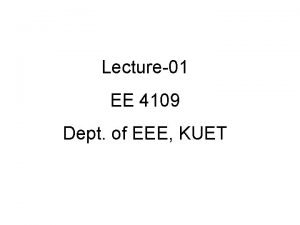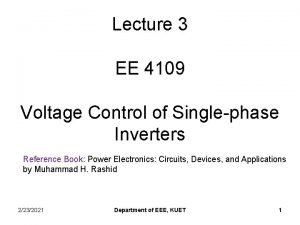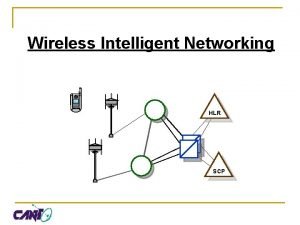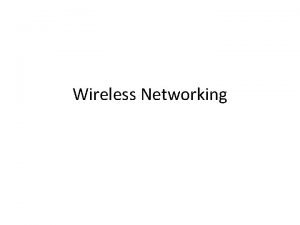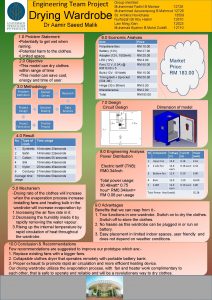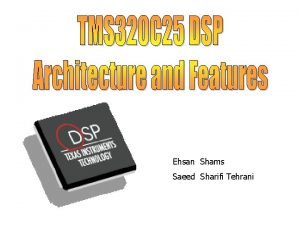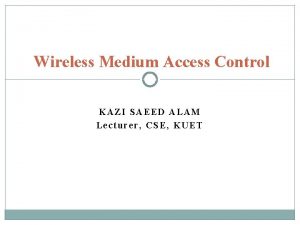Wireless Networking KAZI SAEED ALAM Lecturer CSE KUET




















- Slides: 20

Wireless Networking KAZI SAEED ALAM Lecturer, CSE, KUET

Wireless networks 4 �Infrastructure based networks �Ad hoc networks

Infrastructure based networks 3 � There are no direct communications between wireless nodes � Nodes communicate with each other through access points � Access points control medium access making the topology of the network very simple. � Moreover, these access points act as gateways if there is a necessity for nodes in one network to communicate with nodes in other networks.

Ad hoc networks 4 �Ad hoc wireless networks do not need access points. �Nodes in this network category communicate with each other directly and maintain connectivity in a decentralized manner. �As a result, each node has to implement a medium access control algorithm.

Ad hoc networks 5 �Two very important ad hoc wireless networks: Wireless Sensor Networks (WSNs) Mobile Ad hoc Networks (MANETs) � Vehicular Ad hoc Networks (VANETs)

Wireless Sensor Networks (WSNs) 6 � WSNs are ad hoc networks with a large number of small, inexpensive nodes deployed over geographical areas to monitor physical or environmental conditions.

Wireless Sensor Networks (WSNs) 7 � Each of these nodes has a microcontroller, wireless transceiver, an antenna, a power source (normally a battery), memory, and one or more sensors. � These sensors collect relevant data from the environment and then send or relay that data via the ad hoc network to a central station. � Sensors basically sense heat, light, vibration, sound etc. Sensors Storage microcontroller Transceiver P O W E R WSN device schematics

Wireless Sensor Networks (WSNs) 8 � As the nodes are inexpensive and small in size, they have very limited resources (battery power, memory space, and processing speed). � The nodes are often placed in environments where maintenance (e. g. , replacement of battery or damaged nodes) is difficult � The network lifetime thus depends on the energy efficiency of the sensors. So it is necessary to design algorithms that minimize energy usage.

Characteristics of WSNs 9 � Limited Resources? Limited computational power, bandwidth, and memory capacity. � Network lifetime? Limited battery capacity. � Dense, ad hoc deployment? Deployed densely in ad hoc manner in the area of interest. � Ability to cope with node failures? Nodes may die because of depleted batteries. � Ability to tolerate hostile environmental conditions? Nodes may be deployed in forests, war zones, or harmful industrial environments.

WSN Applications 10 � Military applications Target tracking, battle field surveillance. � Environmental applications Detect forest fires, floods. � Health applications track and monitor the positions and conditions of patients. � Home applications can be attached to home appliances such as vacuum cleaners, refrigerators, DVD players, and water monitoring systems to manage the appliances locally or remotely.

Mobile Ad hoc Networks (MANETs) 11 � MANETs are ad hoc networks comprising mobile nodes. � Nodes in MANETs can move in any direction without restrictions, leading to changes in neighbourhood structure. � As a result, the network topology is altered in a frequent manner. � A class of MANETs Vehicular Ad hoc Networks (VANETs)

Characteristics of MANETs 12 � Mobile ad hoc networks are formed dynamically by an autonomous system of mobile nodes that are connected via wireless links. � No existing fixed infrastructure or centralized administration – No base station. � Mobile nodes are free to move randomly. � Network topology changes frequently. � May Operate as standalone fashion or also can be connected to the larger internet. � Each node work as router.

Challenges of MANETs 13 � Infrastructure less Brings new network designing challenges. � Dynamically changing topologies Cause route changes, frequent network partitions and packet loss. � Physical layer limitations Limited Wireless range. Packet loss during transmission. Broadcast nature of the communication. � Limitations of Mobile Nodes Short battery life Limited capacities. � Network security.

Vehicular Ad hoc Networks (VANETs) 14 � Nodes in VANETs are vehicles that comply with street traffic regulations while moving. VANETs support both vehicle-to-vehicle (V 2 V) and vehicle-to-infrastructure (V 2 I) communications.

Vehicular Ad hoc Networks (VANETs) � V 2 V communications vehicles exchange information with each other. � V 2 I communications involve message exchanges between vehicles and traffic lights or between vehicles and roadside monitors known as road side units (RSUs). The vehicles can access the internet through RSUs. � Each vehicle is equipped with a controller called on-board unit (OBU) that supports the V 2 V and V 2 I communications. 15

Intelligent Transportation Systems (ITS) 16 �The WHO Global status report on road safety states that road accidents cause around 1. 24 million deaths and 20 – 50 million injuries each year. �According to the Texas Transportation Institute the traffic congestion cost in the US was approximately $115 billion based on wasted time and fuel per year. �Intelligent Transportation Systems (ITS) support V 2 V and V 2 I communications by applying information technologies in vehicles and RSUs in order to improve road safety and provide passenger and driver comforts. �Therefore, VANETs form an important part of ITS.

Characteristics of VANETs 17 � Highly Dynamic Topology Due to the fast movement of vehicles. � Variable Node Density number of vehicles in a region varies over time and is dependant on the situation. � Predictable Network Topology move on roads, follow traffic signals, and road signs. � Available Battery Power There is no limitation of battery power. � Enough computational resources Each vehicle is equipped with Global Positioning System (GPS), a high speed CPU, and many sensors.

Applications of VANETs 18 VANETs � VANET applications: Safety applications: Warning about accidents, violation of traffic signals, wrong way driving, and much more. Non-safety applications: Information about near by restaurant, hotels, and gas stations, play on-line game and access the internet.

Localization in WSNs 19 � In a variety of promising applications of WSN’s, acquiring location information of the sensor nodes is crucial. � Without location information, the system or a user would not be able to detect where the collected data are coming from. � Hospitals, animal tracking, used in enterprises to locate assets

Localization in WSNs 20 � GPS can be attached with each node. � Attaching a GPS with each sensor node is expensive in terms of size, cost and energy consumption. � Moreover, GPS devices may not work properly in all environments such as indoors where they do not have direct line-of-sight with the satellites. � Assume that a small fraction of nodes (called seeds) are able to determine their locations at all times. � The nodes whose locations are to be determined are called nonseeds or simply sensor nodes. � Nodes compute their own locations by communicating with each other. � some (possibly all or none) of the nodes can be considered mobile.
 Lecturer's name
Lecturer's name Kuet cse
Kuet cse Eee kuet
Eee kuet Kuet angle
Kuet angle Sdn vs traditional networking
Sdn vs traditional networking Wireless intelligent networking
Wireless intelligent networking Wireless network definition
Wireless network definition What are wireless devices and the wireless revolution
What are wireless devices and the wireless revolution Ziad jarrah
Ziad jarrah Tashfeen saeed
Tashfeen saeed Dr farah saeed
Dr farah saeed John i saeed
John i saeed Dr aamir saeed
Dr aamir saeed Saad azhar saeed ucp
Saad azhar saeed ucp Saeed sharifi
Saeed sharifi Dr.saeed ahmed
Dr.saeed ahmed Dr ayaz saeed
Dr ayaz saeed Saeed khan wayne state
Saeed khan wayne state Dr ayaz saeed
Dr ayaz saeed Primi ove darove nas oce tekst
Primi ove darove nas oce tekst Pilgrim kazı
Pilgrim kazı


